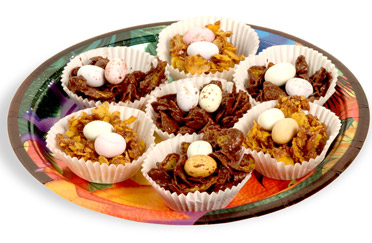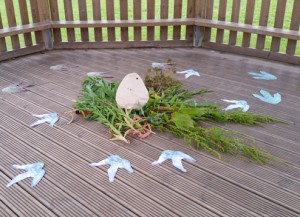Looking for something to do with your young dinosaur fans over the school holiday. Here is a simple and fun recipe for dinosaur chocolate nests, an ideal activity for Easter time. A super idea to help entertain the children, dinosaur chocolate nests for kids.
Dinosaur Chocolate Nests
Ingredients – (makes a batch of about 8 nests)
Plain or Milk cooking Chocolate 225 grammes (8oz)
Packet of Breakfast Cereal Cornflakes or Shredded Wheat variety
Packet of Sugar Coated Mini-chocolate Eggs
Pack of Small Cake Cases
Dinosaur Nests – a Great Holiday Baking Activity

Picture Credit: Everything Dinosaur
Method
1. Break the cooking chocolate into pieces and place in a heat-proof bowl. Melt the chocolate over a pan of simmering water.
2. Once the chocolate has melted remove it from the heat and give it a good stir in the bowl.
3. Add some of the breakfast cereal until the mixture takes on a a brown twiggy look.
4. Carefully spoon enough of the mix into each paper case so that a little nest is formed. Make sure you push it down in the middle so that each nest has a hollow in the centre
5. Place two chocolate mini-eggs in the centre of each chocolate nest, the eggs will stick when the chocolate sets. Two eggs is all you need for each nest (we know that some dinosaurs laid eggs in pairs so your chocolate nests would please a palaeontologist) – see notes below.
6. Then leave the nests to set.
There you are a set of lovely dinosaur themed nests, an ideal activity for young palaeontologists over the Easter break.
For other baking ideas, recipes and for fun party items visit the section of the Everything Dinosaur website that deals with parties: Dinosaur Toys and Gifts.
Dinosaurs and their Nests (a little bit of science)
Many nests of dinosaurs have been discovered, particularly over the last fifteen years or so with the discovery of sauropod nesting sites in Argentina and Europe plus more evidence having been gathered from places such as the famous Flaming Cliffs area of Mongolia.
The first dinosaur eggs were discovered in 1859 (France). The first recognised dinosaur nests were uncovered by an American team of palaeontologists led by Roy Chapman Andrews during expeditions to Mongolia in the 1920s. Over the last few years, scientists have been able to build up their knowledge about dinosaur reproduction and egg laying as egg-shell fragments, nests, and even fossils of unhatched baby dinosaurs inside eggs have been discovered.
The pairs of eggs laid in our pretend chocolate nests are based on the layout of eggs found in theropod dinosaur nests. Many theropod nests (tyrannosaurs, allosaurs, Velociraptors, Oviraptors were theropods); consist of a dug out, roughly bowl shaped hole with pairs of eggs laid are in a circle, pushed into the earth and they are laid in pairs.
A Dinosaur Egg Spotted at a School (STEM Learning)
Picture credit: Everything Dinosaur
Dinosaur Eggs
The laying of eggs in pairs seems to be a unique characteristic of theropod dinosaurs. No other group of animals either around today or found in the fossil record laid eggs in pairs. Theropod eggs tend not to be very round, they are rounded at one end with a more pointed end opposite, a little like a loaf of French bread. The more pointed end is often found buried in the rock which comprises of the fossil, this indicates that the female theropod that laid the eggs, pushed it into the dirt during the process of laying. This is evidence of dinosaurs showing a delicate touch, in the same way that a crocodile cradles newly hatched baby crocodiles in her mouth in readiness to carrying them down to the nursery pool.
The eggs laid in pairs indicate that dinosaurs had two oviducts (the tube in female egg-laying animals where eggs are formed and through which they are laid). The position of fossilised pairs of eggs in theropod nests indicate that eggs were laid from the two oviducts at the same time. This would be the equivalent of a double-barrelled shot gun firing both barrels at once. This behaviour seems unique to theropods. Crocodiles have two oviducts but they do not demonstrate egg laying in pairs. Birds, (believed to be close relatives of theropod dinosaurs), only have one functioning oviduct and only one egg is formed by day. Birds can take several days to lay a clutch of eggs.
Scientists believe that birds evolved only one functioning oviduct and the laying of eggs over a protracted period in order to help them escape from predators. After all, it would be difficult to fly if a female had a clutch of six or seven heavy eggs inside her ready to be laid.
Other scientists have speculated that the laying of eggs over several days may help the pair bond and this may reinforce behaviour towards brooding and feeding the youngsters as they hatch. Yet another theory is that with a delay in laying, comes a delay in the time of hatching, some birds end up with a nest full of offspring, but at slightly different ages. If food becomes scarce then the older siblings can out compete the younger ones and these are the ones that will survive to reach the fledgling stage.
Palaeontologists have a lot to learn about dinosaurs and the egg laying habits, however whilst you contemplate these important aspects of dinosaur behaviour and social habit you can tuck into your own dinosaur nest as a treat. Help yourself to Everything Dinosaur’s chocolate dinosaur nest recipe.







Leave A Comment